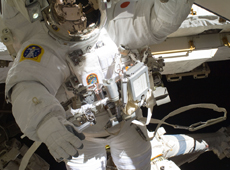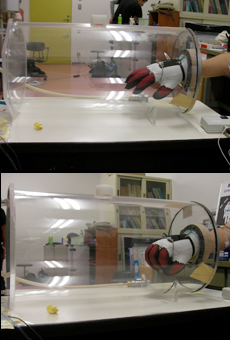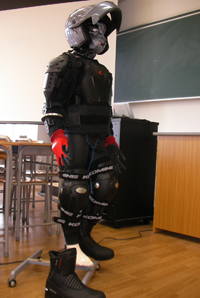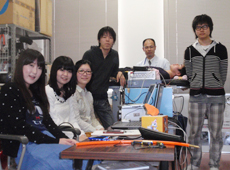Could you tell us about your specialty? What has led you to spacesuit research?

Prof. Kunihiko Tanaka in the United States, where he was studying spacesuits
I specialize in physiology, and I study blood pressure regulation. I became interested in space medicine while studying the impact of gravity changes on blood pressure regulation. I got involved in spacesuit research when I went to the University of California, San Diego, to study with Prof. Alan Hargens, who is well known in the field of space medicine. He was studying the relationship between gravity and blood pressure as well as muscle strength. I moved to the United States in 2000, which was around the time that Prof. Hargens started working with NASA on a new type of spacesuit, and he asked me to help him.
What exactly did you do?
I was responsible for verifying spacesuits. At first I didn’t think that it was a very important role, because it was just verification of what was already made. But I turned out to be wrong. Spacesuits were designed by engineers who were not very familiar with wearers’ bodies. I didn’t see any spacesuits that would be comfortable to wear. So I thought that maybe we, experts in medicine and biology, needed to come up with some ideas for wearer-friendly spacesuits. So since I returned to Japan in 2003, I’ve been studying spacesuits.
From a medical point of view, what are the problems of current spacesuits?

Astronaut Akihiko Hoshide performing a spacewalk. The internal pressure of the spacesuit is maintained at 0.3 atm. (courtesy: JAXA/NASA)
There are two major problems: low mobility and a risk of decompression sickness. In space there is, of course, no air. So when you wear a spacesuit filled with air, the suit fully inflates due to the pressure differential with the exterior, and that greatly limits your movement. It’s like a balloon, which is usually soft but becomes hard to bend when it’s fully inflated. So the solution has been to set the internal pressure in a spacesuit at 0.3 atm (or 0.4 atm for Russian spacesuits). But this can cause decompression sickness.
What is that?
We inhale mainly oxygen and nitrogen. The inside of the International Space Station has the same pressure as on Earth, 1 atm. But when the pressure is lowered to 0.3 atm, nitrogen in the blood cannot be dissolved completely, and they form bubbles – just like the fizzy bubbles produced in beer. When the bubbles clog the vessls in the lungs, or tissues in the body, they can cause a potentially fatal condition called decompression sickness. To prevent this, astronauts must purge nitrogen from their blood little by little before they go on a spacewalk. The problem is the amount of time required for this “prebreathe” process. During the Space Shuttle era, it took 12 hours or more. Although the protocol seems to have been improved and shortened by several hours, it still doesn’t allow astronauts to put on spacesuits quickly and go outside to deal with an emergency.
Are there any ideas for improvement?
Improving the mobility of a spacesuit and preventing decompression sickness are two different things, and there is a contradiction between them. Lowering the internal pressure can reduce the inflation of the spacesuit and improve mobility, but this increases the risk of decompression sickness. Conversely, increased pressure will reduce the risk of decompression sickness, but it will inflate the spacesuit more, reducing mobility. This means that, in my opinion, high pressure is acceptable as long as the suit is comfortable to move in. So, to improve mobility, I thought I would try making a spacesuit using a stretch material. For the internal pressure within the spacesuit, I am aiming for 0.65 atm, which will not require a prebreathe protocol. I started by experimenting with spacesuit gloves.
What kind of stretch material? And what advantages does it have?
Such a material increases elasticity as it is stretched, as with pantyhose and rubber, for example. When pressure is applied to the material to inflate it, the material tries to return to its original shape, and I thought that would assist the movement of muscles. In short, it would take less effort to move.
Are there any other advantages?
Yes, there are. The current spacesuit basically consists of a nylon pressure bladder to maintain appropriate pressure, covered by a fabric pressure-restraint layer to prevent it from bursting. If the spacesuit fully inflates, the material stiffens, which causes problems. For example, when you bend your fingers, the back of the hand or the joints can rub against the material, which can cause irritation or even scarring. Or a fingernail can catch on the material and tear, which can be painful. But with a stretch material, the finger joints are not compressed when they are bent, because the material is stretchable. In addition, because the material adapts to the shape of the body, the backs of the fingers are not subject to unnecessary extra pressure. I think this also makes a stretch material excellent for spacesuits.
You started with research on spacesuit gloves. Could you tell us what you have found so far?

The mobility of a spacesuit glove is verified by placing a hand with a stretch glove in a low-pressure chamber.
I’ve found that using a stretch material improves the mobility of the fingers. The experiment was done by placing a hand, with a spacesuit glove on, in a sealed chamber, and bending the fingers at a pressure differential of 0.65 atm. I then took an electromyogram – a picture of the electrical activity produced by the movement of muscles. The experiment showed that the amplitude in the electromyogram was smaller with the stretch material than with non-stretchable material. That means the stretch material requires less effort to move.
Are you now working on other parts of the spacesuit?
I am studying the shoulder and hip joints. The fingers can bend in only one direction, but the shoulders and hips can rotate 360 degrees, so this requires ingenuity. The elbows and knees bend in only one direction like the fingers, so they are manageable. And the neck, I think it will be possible to move if the helmet is wide enough. The current spacesuits seem to require some kind of technique to move the shoulders, so I’m hoping to come up with an idea to improve the mobility of the shoulder joints.
Right now, building simulation models, I’m trying a variety of things. University is a place for research, so we have the advantage of being able to use trial and error to try all kinds of things. Research is about achieving results by failing over and over. I’m hoping that, in my university lab, I can firmly establish the key principles of spacesuits, and once that’s done, I can work on development with a private-sector company or JAXA. We’re doing this research with as little money as possible, so we work with materials that are commercially available. It’s not realistic to take such a thing to space, so collaboration is essential. Anyway, for now I am dedicated to the establishment of the key principles of spacesuits. As long as the principles are sound, the application part will be easy.
Were you studying stretch materials in the U.S., too?
I was studying stretch materials, but the method for preventing decompression sickness was different. Back then in the U.S., instead of lowering the pressure inside the spacesuit, pressure was applied by tightening the wearer’s body with a highly stretchable material. It’s been shown that this method can perform the same function as pressurization with air pressure. But this method, though it can evenly pressurize the curves of the fingers, arms and feet, doesn’t work for dented parts, such as the armpits. For example, when pantyhose are put on, the crotch is hardly pressurized. Leaving an area non-pressurized, there is risk of decompression sickness or bruising, so I didn’t think that method was very effective. That’s how I decided to pursue pressurization with air pressure.
Were you interested in space as a child?

A display model of the Knight Suit spacesuit, invented by Prof. Tanaka
I wasn’t particularly interested in space, but if anything, I liked watching space anime on TV. For instance, there was an anime called “Tekkaman: The Space Knight.” Tekkaman’s spacesuit was very cool, and I thought I wanted to make and wear such a spacesuit myself someday. (laugh) I completely forgot about this for a long time. But one day, after I started working on spacesuits, it flashed across my mind, and I had a good look at Tekkaman’s spacesuit.
Tekkaman’s spacesuit?! (laugh)
To put it on, Tekkaman gets into the robot and shuts the door. This is an airlock. Then he wraps himself in something like long chains. That is, he applies pressure to prevent decompression sickness. And finally he puts on the spacesuit over top and takes off for space. From the time he enters the robot until he takes off, it takes only about 10 seconds. His only oxygen is in the helmet. I don’t know how much thought was put into this anime, but the spacesuit I was working on in the U.S. actually used the same pressurization method – applying pressure to the wearer’s body – so I was surprised at how realistic the anime was.
So your spacesuit is inspired by “Tekkaman: The Space Knight.”
That’s right. That’s why I decided to name the spacesuit “Knight Suit,” and I’ve trademarked the name.
It’s a cool name. It sounds like the spacesuit could play an important role not only in space but also on the ground.
It is a cool name, isn’t it? On the ground, I think the spacesuit could serve as safety wear for extreme environmental conditions, for example in extremely hot or cold places. But, actually, I am hoping it will be used for picking up space debris.
Today, space debris is a serious concern, and there is an idea to launch a robot to remove it. But I think it would be more effective to have humans do this, because people can better adapt to circumstances. To build the ISS and repair the Hubble Space Telescope, it was people who went to do these jobs. I’m hoping that the Knight Suit will play a role in that area.
People may laugh and say that this is all just a pipe dream. They may think that there is no need for a spacesuit because Japan doesn’t have a rocket to launch a person into space. But when there is demand for spacesuits in the future, at least I want to be able to suggest one. It can’t be built in a day, so I think we need to start now.
Yes. I think that there is meaning in continuing spacesuit research.
It’s been almost 10 years since I started these experiments, in 2004. I am actually surprised I’m still doing it. (laugh) If you want to study space medicine, there is really no place to do it in Japan, and not much research money available. Nonetheless, I’ve been doing it because there are a lot of dreams about space. Talking about a dream is fun, and it stimulates my motivation. Thinking only about daily work gives me a headache, but thinking about the future cheers me up. It’s fun to imagine an astronaut one day wearing my spacesuit! To tell you the truth, I am always talking about this kind of stuff to my students. (laugh) Students used to ask me if spacesuit research was my hobby. But these days, finally, although the number is still small, some students have started to show interest in this work, just because they find it interesting. I can’t force them, but it makes me happy if even one student becomes interested in spacesuits. I would like to continue telling students about my dreams.
Your dreams seem to keep opening up.
I guess so. There are many things I want to do. Oftentimes I fail, but the failures are gradually becoming less frequent, and I like that. In the U.S., my first job was to make laboratory equipment for spacesuits. I had never done anything like that before, so it was a matter of repetition: building it and wrecking it. The experience was definitely good training for me, though. There were times when I felt dejected because I couldn’t do it right no matter how many times I tried. But as I improved, little by little, I became confident that someday I could do it right. When I couldn’t achieve the result I wanted, I thought hard about a solution. I think that it was good training. Thanks to that work, the process of trial and error no longer bothers me so much.
Is spacesuit research the only thing you’re working on?

Prof. Tanaka with students in his lab.
No, no. I couldn’t make a living that way! (laugh) I am continuing my research on blood pressure regulation. When a person gets up from bed, blood goes down to the legs. And when less blood goes up to the head, it causes lightheadedness. In the case of elderly people, they can fall over and injure themselves.
It’s now becoming clear that the ears have something to do with blood pressure regulation. I find it interesting that commands are actually sent from seemingly unrelated areas. This research is as satisfying to me as spacesuit research. Blood pressure research can be related to research on the impact of space flight on the human body, so it would be ideal if there were a place where these two topics could be studied at the same time.
Like a center for space medicine.
Exactly! I think there should be a facility specializing in space medicine. It could have a spacesuit training facility, too. I would be delighted if I were invited to such a place. I would love to have a chance to ask Japanese astronauts directly about extravehicular activity. In particular, I want to ask them what the inside of a spacesuit is like.
What are your expectations for future Japanese manned space exploration?
Today Japan’s manned space program is wholly dependent on the United States and Russia, so we won’t be able to start human spaceflights by ourselves immediately. But at least, I hope Japan will be able to make original proposals on key points. The unmanned resupply spacecraft to the ISS, the H-II Transfer Vehicle, was launched on a domestic rocket. As far as human spaceflight, instead of just depending on foreign rockets to launch Japanese astronauts, I think Japan would have a stronger presence in the world if it could make original proposals, such as sending Japan-made spacesuits for testing.
Finally, what are your ambitions for the future?
I have to complete at least one version of the Knight Suit. I would like to build a body-shaped spacesuit using a stretch material as soon as possible, and announce it to the whole world. I am hoping that I can bring it to a level where a person could actually put it on in the next three years. I hope you can come to the unveiling of the Knight Suit when it’s ready!
Professor, Department of Radiological Technology, Faculty of Health Science, Gifu University of Medical Science
Prof. Tanaka graduated from the Graduate School of Medicine at Kagawa University in 1995, and assumed a position at the Department of Thoracic and Cardiovascular Surgery at the Osaka Saiseikai Nakatsu Hospital. Subsequently, he worked at the Department of Surgery at Shiso County Hospital from 1996, followed by the Department of Surgery at Hyogo Prefectural Awaji Hospital from 1998. In 2000, he moved to the United States to study at the Clinical Physiology Laboratory at the University of California, San Diego, where he worked on R&D for a new type of spacesuit in collaboration with NASA and Honeywell. In 2003, he became an assistant professor at the Department of Physiology at Gifu University Graduate School of Medicine. He has been in his current position since 2009.
Go for Space!
A Mini Spaceship for One
Building a Good-Looking Spacesuit
Building a Better Spacesuit with Medicine
